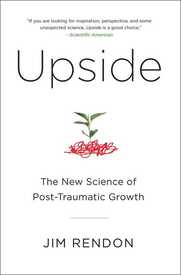Author: Jim Rendon
ISBN-10: 1476761639
ISBN-13: 978-1476761633
APA Style Citation
Rendon. (2015). Upside: The new science of Post-Traumatic Growth. New York, NY: Touchstone.
Buy This Book
www.amazon.com/Upside-New-Science-Post-Traumatic-Growth/dp/1476761639
| upside_activity.pdf |
| upside_activity.pdf |
As teachers of psychology, we often devote considerable time and attention to mental illness and treatment while spending significantly less time on positive psychology or the scientific study of strengths and the potential to grow from negative experiences.
According to the DSM-5, individuals may receive a diagnosis of Post-traumatic stress disorder (PTSD) from exposure to three types of traumatic events:
- The event happened to them personally
- They learn that a traumatic event happened to a family member or a close friend
- They experienced repeated exposure to a traumatic event (e.g., first responders, caretakers).
- Intrusion (e.g., involuntary distressing memories, flashbacks, nightmares)
- Avoidance (e.g., hiding from distressing memories, dodging reminders of the event)
- Negative changes in thoughts and mood (e.g., negative beliefs about oneself, numbness, detachment from others)
- Increased arousal and reactivity (e.g., exaggerated startle response, irritability, problems concentrating, sleep difficulties)
After an extremely dangerous or life-threatening event, most individuals have initial symptoms, and in most cases, those symptoms go away on their own. For some, the symptoms continue, and PTSD may be diagnosed. There is, however, research related to how these same events ultimately lead to post-traumatic growth (PTG), which is the subject of the book, Upside. While it is critical to teach and build an understanding of PTSD, it is equally important to illustrate that the types of experiences that lead to PTSD do not always result in the condition. In reality, most individuals who experience a traumatic event do not develop PTSD.
The book Upside, traces the development of research into the potential positive benefits of trauma that began in the 1980’s. Two psychology professors from the University of North Carolina at Charlotte, Richard Tedeschi and Lawrence Calhoun built the initial research on individuals who had been devastated by losses including accidents and illness. Another early study conducted by a psychiatrist and professor at the Yale School of Medicine named William Sledge covered what would become post-traumatic growth in aviators who were POWs during the Vietnam War, which was published in 1980. Interest in the field grew slowly as more research funding was devoted to PTSD. While examples of post-traumatic growth have been documented for thousands of years, it was not a focus of scientific inquiry until the 1980’s. Tedeschi and Calhoun continued their research and found that individuals who experienced positive outcomes post-trauma experienced changes in one or more of the following areas:
- Greater inner strength
- An openness to new life possibilities
- Closer and deeper relationships with friends and family
- An enhanced appreciation for life
- A stronger sense of spirituality
Research indicates that PTSD is not inevitable after trauma, but that it is less likely than PTG. More individuals develop growth as opposed to PTSD post-trauma. Since the first book on PTG was published by Tedeschi and Calhoun, researchers around the world have been further documenting the incidence of posttraumatic growth. On their website, Tedeschi and Calhoun make some key clarifications about post-traumatic growth research (Calhoun & Tedeschi, 2014):
- Most of us, when we face very difficult losses or great suffering, will have a variety of highly distressing psychological reactions. Just because individuals experience growth does not mean that they will not suffer. Distress is typical when we face traumatic events.
- We most definitely are not implying that traumatic events are good – they are not. But for many of us, life crises are inevitable, and we are not given the choice between suffering and growth on the one hand, and no suffering and no change, on the other.
- Post-traumatic growth is not universal. It is not uncommon, but neither does everybody who faces a traumatic event experience growth.
- Our hope is that you never face a major loss or crisis, but most of us eventually do, and perhaps you may also experience an encounter with post-traumatic growth.
Other Related Resources
Author Jim Rendon
Author website: https://www.jimrendon.com/
Author contact information
Follow on Twitter: @RendonJim
Posttraumatic Growth Research Group
https://ptgi.uncc.edu/ptg-research-group/
Remarkable Resiliency: George Bonanno, Ph.D. on PTSD, Grief, and Depression
George A. Bonanno presentation at the Association for Psychological Science (2020)
https://www.psychologicalscience.org/observer/bonanno
National Institute of Mental Health information on Post-Traumatic Stress Disorder
https://www.nimh.nih.gov/health/topics/post-traumatic-stress-disorder-ptsd/index.shtml#part_145371
Man's Search for Meaning
Viktor Frankl's influential book which tells his Holocaust survival story and how it inspired the
treatment method he developed, logotherapy.
Frankl, V. E., Lasch, I., Kushner, H. S., & Winslade, W. J. (2019). Man's search for meaning.
Boston: Beacon Press.
1972 video of Viktor Frankl speaking
https://www.ted.com/talks/viktor_frankl_why_believe_in_others
Posttraumatic Growth Article
American Psychological Association article from the Monitor on Psychology about posttraumatic growth
http://www.apamonitor-digital.org/apamonitor/201611?pg=1#pg1
Collier, L. (2016, November). Growth after trauma: Why are some people more resilient
than others—and can it be taught? Monitor on Psychology, 47(10), 48-51.
doi:https://www.apa.org/monitor/2016/11/growth-trauma
Psychologist Sonja Lyubomirsky discussion of posttraumatic growth
https://www.youtube.com/watch?v=9PG71LHinQc
Psychological Figures and Concepts
Viktor Frankl
Joseph LeDoux
Jean Piaget
Martin Seligman
Accommodation
Amygdala
Assimilation
Cerebellum
Cognitive-behavioral therapy
Creativity
Deliberate rumination
Diagnostic and Statistical Model, 5th Edition
Dual-pathway of fear
Expressive writing therapy
Fight-or-flight response
Flow
Gratitude
Just-world phenomenon
Individualistic culture
Logotherapy
Openness to experience
Optimism
Positive psychology
Prefrontal cortex
Post-traumatic growth (PTG)
Post-traumatic growth inventory
Post-traumatic stress disorder (PTSD)
Thalamus
Traumatic brain injury (TBI)

 RSS Feed
RSS Feed